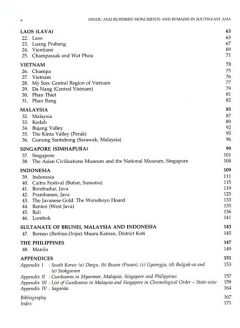Indian religious art and culture have exercised and extraordinary influence on South-East Asia (earlier called Greater India or Further India). All across South-East Asia, Indian religious world inspired the raising of astonishing monuments, some of which remained unequalled even in the mother country. The Sailendra (Lords of Mountains) rulers of Java (Indonesia) built the magnificent ninth century Mahayana Buddhist stupa of Borobudur, the largest Buddhist monument in the world and an invaluable heritage of mankind. At a short distance was built the great Hindu complex of Prambanan. In central Myanmar, more than 2,000 red-brick temples and monuments mark the city of Pagan, for 400 years the capital of people who also dedicated much of their labour and wealth to the service of their faith. Angkor in Cambodia can boast of the world’s largest religious monument and most inspired and spectacular temple complex in the world, which is dedicated to Vishnu. Ayutthaya, a vast and majestic city of Thailand, has 400 splendid temples. In Vietnam, three important groups of temples are My Son, Dong Duong and Po Nagar, the second being Buddhist and the other two Saivite. The first royal Sivalinga in South-East Asia was established at My Son and the oldest Sanskrit inscription was found in a village called Vo Canh near Nha Trang in the southern part of Vietnam. Wat Phou is Laos’ own mini-Angkor. It preserves the glory of Hinduism far away from the land of its origin, the Indian sub-continent. To know Indian art in India alone, is to know but half its story. To apprehend it to the full; one must watch it assuming new forms and breaking into new beauties as it spreads over Myanmar, Thailand and Vietnam; one must gaze in awe at the unexampled grandeur of its creation in Cambodia and Java. In each of these countries, Indian art encounters a different racial genius, a different local environment, and under their modifying influence it takes on a different garb. Therefore the art of each and everyone of these countries is complimentary to the rest and a knowledge of each, such as this book provides, is indispensable to our understanding of the whole.
Hindu and Buddhist Monuments and Remains in South-East Asia
Add to favorites
Contents
$99.00
$110.00
In stock
Free & Quick Delivery Worldwide
All orders amounting to US$ 50 or more qualify for Free Delivery Worldwide. For orders less than US$ 50, we offer Standard Delivery at $14 per book.
ABOUT THE AUTHOR Amar Nath Khanna
Shri Amar Nath Khanna was born at Multan in West Punjab in 1936. He holds a Master's degree in History and a Post Graduate Diploma in Archaeology from the School (presently Institute) of Archaeology, Archaeological Survey of India, New Delhi. Shri Khanna has had the rare opportunity of visiting and studying monuments and pilgrim shrines scattered all over the Indian Sub-continent, China, Japan, Nepal and Singapore during the last about half a century. He retired as Senior Technical Officer, Indira Gandhi National Centre for the Arts, New Delhi, in 1996 while earlier he had been working as a Senior Officer with the President of India. In 1998, he was invited again by Shri R. Venkataraman, Former President of India, to work with him even after retirement. He had been the Registering Officer for Antiquities in Himachal Pradesh and was associated with Shri Rajeev Sethi, Padma Bhushan, in the Aditi Exhibition curated by him in the Festival of India, U.S.A., and the Basic Human Need Pavilion set up in Germany in 1998. He was associated with Smt. Pupal Jayakar, Adviser to Prime Minister on Heritage and Cultural Resources, in the Festivals of India held in the U.S.A. and Japan and the Year of India in France. He was a Member of the Presidential Delegations which had visited Japan in 1990 and China in 1992. From 1957, he was a member of the Archaeological Survey of India for about two decades. Shri Khanna's book Archaeology of India was published in 1981. Its revised and enlarged edition which covered Pakistan and Bangladesh also was published in 1992 and was highly appreciated among others by the President of India and Dr. Karl Khandalavala. Shri Khanna's research papers have been published in leading journals in India. Currently, Shri Khanna is Secretary, Indo-Tibetan Art& Culture Study Group, New Delhi, and Executive Member, Rasaja Foundation, New Delhi.
reviews
0 in total
Review by Anonymous
Be the first to review “Hindu and Buddhist Monuments and Remains in South-East Asia” Cancel reply
You must be logged in to post a review.
Bibliographic information
Title
Hindu and Buddhist Monuments and Remains in South-East Asia
Author
Edition
1st ed.
Publisher
ISBN
9788173053481
Length
xxviii+178p., 42 Colour & 63 B/w Plates; 3 Maps; Bibliography; Index; 28cm.
Subjects
more by Amar Nath Khanna see more
Pilgrim Shrines of India: Mythology, Archaeology, History and Art
The tradition of visiting ...
$88.20
$98.00
The Diverse World of Indian Painting: Essays in Honour of Dr. Vishwa Chander Ohri
The Diverse World of Indian ...
$231.30
$257.00











There are no reviews yet.